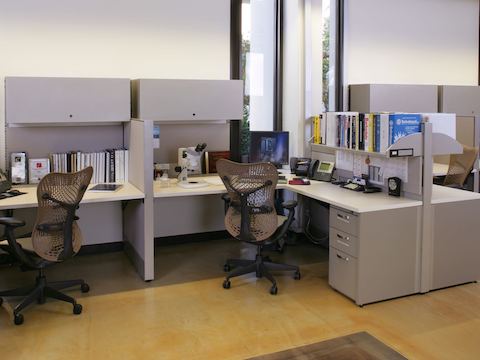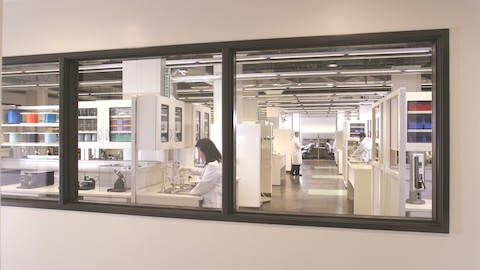If you scoured the eight buildings on the sprawling campus of Edwards Lifesciences you'd never find a less likely location for a new research laboratory than the one Edwards chose—a former machine shop.
Lathes, mills, grime—that it had. But as for the aesthetic and functional qualities you'd want in a showcase lab—a place responsible for impressing customers and investors—those were in short supply.
Not anymore. Edwards' one-time machine shop has been transformed into the highlight of the corporate tour, a gleaming research lab that consolidates many of the company's product development teams in one location and looks great doing so.
"We strongly believe that our buildings need to reflect our identity and help market our products," says Dennis Shoji, senior director of facilities for Edwards Lifesciences, the world's foremost maker of heart valves and other devices for treating cardiovascular disease. "Here, we wanted to show off a little."
Deservedly so. Edwards boasts such a history of innovation that its Irvine campus is home to the Museum of Heart Valve Design, which recounts the breakthroughs that paved the way for many of today's cardiovascular therapies. To keep the breakthroughs coming, the company plows 10 percent of sales back into R&D—a sizable amount earmarked for the activities that take place in its new lab.
"Edwards wanted more than just a functional research lab," says David Oh, a partner with Studio SA, the Santa Ana, California, architecture firm that designed the space. "It wanted a showcase that would attract visitors and tell the Edwards story."
A View Inside
Mr. Oh and partner Greg Sadowski helped the lab double as a showcase by incorporating stained concrete floors, European lighting, and a judicious dose of color. What's more, the architects dismissed the drop ceiling so common in lab environments, choosing instead to create a roomier feel with exposed ductwork.
The showcase mandate was further achieved by building a corridor around the perimeter of the lab. Strategically placed windows allow visiting surgeons and investors to see inside, while video kiosks at four stops along the way explain what's going on. At one point, the corridor juts off into a glass-walled viewing area that offers a prospect of the entire space.
Occasionally, visitors aren't content with the perimeter perspective and ask to step inside. Once they do, they get an up-close view of the casework that's largely responsible for making the lab work as well as it looks—the Co/Struc system from Herman Miller.
The Case For Change
Unlike the fixed casework common in many research labs, Co/Struc casework is modular and movable—work surfaces, storage components, and panels are all independent of each other, so individual pieces can be reconfigured easily.
"Flexibility was crucial for us because our product development teams change every six months or so," says Myron Howanec, the lab manager. "New projects, new people, new technology—we never know what's coming next. Plus, we can usually reconfigure things ourselves without calling in the facilities guys."
"The Co/Struc system was a perfect fit, given that the space needed to be modified so quickly," says architect Oh of Studio SA.
Mr. Oh also tapped Herman Miller to provide Mirra seating for 18 workstations situated along one wall of the lab. Why?
"Anytime you introduce one vendor, and then another, it becomes something of an installation nightmare," he says. "Using just one resource for both the lab and administrative products ensured that we'd get everything done right."

And now that it is done, Edwards' showcase lab has become something more—a model for the 200,000 or so square feet of lab space scattered around the company's Irvine campus. As Edwards upgrades and expands other labs, it incorporates products proven successful in the showcase lab, most notably Co/Struc movable, modular casework.
The project was a collaboration between Herman Miller dealer Workplace Resource of Costa Mesa and Herman Miller healthcare designers Carolyn Crout in South Carolina and Jamie Levine in Dallas, who handled the design development drawings and specifications.
"Everyone wants to mimic this lab," says John Barrow, the Herman Miller for Healthcare sales rep on the project. "It has helped give Edwards the flexibility needed to continue building on its hallmark of innovation."
